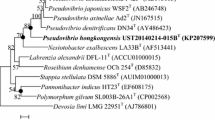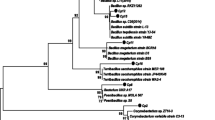Abstract
A novel, Gram-stain positive, facultative anaerobic, non-motile and straight to curve rod shaped bacterium, strain LV19T was isolated from the larval gut of the rhinoceros beetle, Trypoxylus dichotomus, which was collected from Yeong-dong, Chuncheongbuk-do, South Korea. The colonies of the new isolate were convex, circular, cream white in color and 1–2 mm in diameter after 3 days incubation on Tryptic Soy Agar at 37 °C. Based on the 16S rRNA gene sequence similarity, the new isolate was most closely related to Erysipelothrix inopinata MF-EP02T, E. rhusiopathiae ATCC 19414 T and E. tonsillarum T-305T (94.8, 93.8 and 93.7 % similarity, respectively). Strain LV19T grew optimally at 37 °C, at pH 8.0 and in the presence of 0.5 % (w/v) NaCl. Oxidase activity and catalase activity were negative. The major cellular fatty acids (>10 %) were C18:2 cis-9,12 (28.9 %), C18:1 cis-9 (22.3 %), C16:0 (22.2 %) and C18:0 (18.5 %). The cell-wall hydrolysates contained ribose as a major sugar. Major polar lipids were phosphatidylglycerol and three unidentified glycolipids. No quinone was detected. The G+C content of the genomic DNA was 36.3 mol%. The levels of DNA–DNA relatedness between strain LV19T and all the reference strains were less than 20 %. On the basis of polyphasic evidence from this study, the isolate is considered to represent a novel species of the genus Erysipelothrix, for which the name Erysipelothrix larvae sp. nov. is proposed; the type strain is LV19T (=KCTC 33523T = DSM 28480T).




Similar content being viewed by others
Abbreviations
- PG:
-
Phosphatidylglycerol
- GL:
-
Unidentified glycolipid
- PL:
-
Unidentified phospholipid,
- AL:
-
Unidentified aminolipid,
- APGL:
-
Unidentified aminophosphoglycolipid
- TSA:
-
Tryptic Soy Agar
- rpm:
-
Revolution per minute
References
Becker B, Lechevalier MP, Lechevalier HA (1965) Chemical composition of cell-wall preparations from strains of various form-genera of aerobic actinomycetes. Appl Microbiol 13:236–243
Bowman JP (2000) Description of Cellulophaga algicola sp. nov., isolated from the surfaces of antarctic algae, and reclassification of Cytophaga uliginosa (ZoBell and Upham 1944) Reichenbach 1989 as Cellulophaga uliginosa comb. nov. Int J Syst Evol Microbiol 50:1861–1868
Brooke CJ, Riley TV (1999) Erysipelothrix rhusiopathiae: bacteriology, epidemiology and clinical manifestations of an occupational pathogen. J Med Microbiol 48:789–799
Chang DH, Lee JB, Lee GH, Rhee MS, Lee H, Bae KS, Park DS, Kim BC (2013) Sunxiuqinia dokdonensis sp. nov., isolated from deep sub-seafloor sediment. J Microbiol 51:741–746
Cho JC, Giovannoni SJ (2003) Parvularcula bermudensis gen. nov., sp. nov., a marine bacterium that forms a deep branch in the α-Proteobacteria. Int J Syst Evol Microbiol 53:1031–1036
Collins MD, Lawson PA, Willems A, Cordoba JJ, Fernandez-Garayzabal J, Garcia P, Cai J, Hippe H, Farrow JAE (1994) The phylogeny of the genus Clostridium: proposal of five new genera and eleven new species combinations. Int J Syst Bacteriol 44:812–826
Dillon R, Charnley K (2002) Mutualism between the desert locust Schistocerca gregaria and its gut microbiota. Res Microbiol 153:503–509
Ezaki T, Hashimoto Y, Yabuuchi E (1989) Fluorometric deoxyribonucleic acid-deoxyribonucleic acid hybridization in microdilution wells as an alternative to membrane filter hybridization in which radioisotopes are used to determine genetic relatedness among bacterial strains. Int J Syst Bacteriol 39:224–229
Felsenstein J (1981) Evolutionary trees from DNA sequences: a maximum likelihood approach. J Mol Evol 17:368–376
Felsenstein J (1985) Confidence limits on phylogenies: an approach using the bootstrap. Evolution 39:783–791
Fitch WM (1971) Toward defining the course of evolution: minimum change for a specific tree topology. Syst Zool 20:406–416
Gerhardt P, Murray RGE, Wood WA, Krieg NR (1994) Methods for general and molecular bacteriology. American Society for Microbiology, Washington
Hassanein R, Sawada T, Kataoka Y, Gadallah A, Suzuki Y (2003) Molecular identification of Erysipelothrix isolates from the tonsils of healthy cattle by PCR. Vet Microbiol 95:239–245
Heimbrook ME, Wang WLL, Campbell G (1989) Staining bacterial flagella easily. J Clin Microbiol 27:2612–2615
Kim OS, Cho YJ, Lee K, Yoon SH, Kim M, Na H, Park SC, Jeon YS, Lee JH, Yi H, Won S, Chun J (2012) Introducing EzTaxon-e: a prokaryotic 16S rRNA Gene sequence database with phylotypes that represent uncultured species. Int J Syst Evol Microbiol 62:716–721
Kiuchi A, Hara M, Pham HS, Takikawa K, Tabuchi K (2000) Phylogenetic analysis of the Erysipelothrix rhusiopathiae and Erysipelothrix tonsillarum based upon 16S rRNA. DNA Seq 11:257–260
Kurosawa Y (1985) Siiphidae. In: Ueno S, Kurosawa Y, Sato M (eds) The Coleoptera of Japan in Color, vol 2. Hoikusha, Osaka
Lee GH, Rhee MS, Chang DH, Lee J, Kim S, Yoon MH, Kim BC (2013a) Oscillibacter ruminantium sp. nov., isolated from the rumen of Korean native cattle. Int J Syst Evol Microbiol 63:1942–1946
Lee JH, Kumar S, Lee GH, Chang DH, Rhee MS, Yoon MH, Kim BC (2013b) Methanobrevibacter boviskoreani sp. nov., isolated from the rumen of Korean native cattle. Int J Syst Evol Microbiol 63:4196–4201
Lee GH, Rhee MS, Chang DH, Kwon KK, Bae KS, Yang SH, Kim BC (2014) Bacillus solimangrovi sp. nov., isolated from mangrove soil. Int J Syst Evol Microbiol 64:1622–1628
Mesbah M, Premachandran U, Whitman WB (1989) Precise measurement of the G + C content of deoxyribonucleic acid by highperformance liquid chromatography. Int J Syst Bacteriol 39:159–167
Migula W (1900) System der Bakterien, vol 2. Gustav Fischer, Jena
Park DS, Oh HW, Jeong WJ, Kim H, Park HY, Bae KS (2007) A culture-based study of the bacterial communities within the guts of nine longicorn beetle species and their exo-enzyme producing properties for degrading xylan and pectin. J Microbiol 45:394–401
Ryu JH, Kim SH, Lee HY, Bai JY, Nam YD, Bae JW, Lee DG, Shin SC, Ha EM, Lee WJ (2008) Innate immune homeostasis by the homeobox gene caudal and commensal-gut mutualism in Drosophila. Science 319:777–782
Saitou N, Nei M (1987) The neighbor-joining method: A new method for reconstructing phylogenetic trees. Mol Biol 4:406–425
Skerman VBD, McGowan V, Sneath PHA (1980) Approved lists of bacterial names. Int J Syst Bacteriol 30:225–420
Stackebrandt E (2009) Genus I. Erysipelothrix. In: Vos PD, Garrity GM, Jones D, Krieg NR, Ludwig W, Rainey FA, Schleifer KH, Whitman WB Bergey’s Manual of Systematic Bacteriology, Springer, New York, pp. 1299–1306
Takahashi T, Fujisawa T, Benno Y, Tamura Y, Sawada T, Suzuki S, Muramatsu M, Mitsuoka T (1987a) Erysipelothrix tonsillarum sp. nov. isolated from tonsils of apparently healthy pigs. Int J Syst Bacteriol 37:166–168
Takahashi T, Hirayama N, Sawada T, Tamura Y, Muramatsu M (1987b) Correlation between adherence of Erysipelothrix rhusiopathiae strains of serovar 1a to tissue culture cells originated from porcine kidney and their pathogenicity in mice and swine. Vet Microbiol 13:57–64
Takahashi T, Fujisawa T, Yamamoto K, Kijima M, Takahashi T (2000) Taxonomic evidence that serovar 7 of Erysipelothrix strains isolated from dogs with endocarditis are Erysipelothrix tonsillarum. J Vet Med B Infect Dis Vet Public Health 47:311–313
Tamura K, Peterson D, Peterson N, Stecher G, Nei M, Kumar S (2011) MEGA5: molecular evolutionary genetics analysis using maximum likelihood, evolutionary distance, and maximum parsimony methods. Mol Biol Evol 28:2731–2739
Thompson JD, Gibson TJ, Plewniak F, Jeanmougin F, Higgins DG (1997) The clustal_X windows interface: Flexible strategies for multiple sequence alignment aided by quality analysis tools. Nucleic Acids Res 25:4876–4882
Tindall BJ (1990a) A comparative study of the lipid composition of Halobacterium saccharovorum from various sources. Syst Appl Microbiol 13:128–130
Tindall BJ (1990b) Lipid composition of Halobacterium lacusprofundi. FEMS Microbiol Lett 66:199–202
Verbarg S, Rheims H, Emus S, Frühling A, Kroppenstedt RM, Stackebrandt E, Schumann P (2004) Erysipelothrix inopinata sp. nov., isolated in the course of sterile filtration of vegetable peptone broth, and description of Erysipelotrichaceae fam. nov. Int J Syst Evol Microbiol 54:221–225
Wang Q, Chang BJ, Riley TV (2010) Erysipelothrix rhusiopathiae. Vet Microbiol 140:405–417
Wood RL, Shuman RD (1975) Swine erysipelas. In: Dunne HW, Leman AD (ed) Diseases of Swine, 4th edn. State University Press, Ames, IA, p 565–620
Zillig W, Holz I, Janekovic D, Klenk H-P, Imsel E, Trent J, Wunderl S, Forjaz VH, Coutinho R, Ferreira T (1990) Hyperthermus butylicus, a hyperthermophilic sulfur-reducing archaebacterium that ferments peptides. J Bacteriol 172:3959–3965
Acknowledgments
This work was supported by the Research Program for Agricultural Science & Technology Development (Project No. PJ010168) and was partially supported by grants from the National Research Foundation of Korea (NRF) (2008-2004721), the KRIBB Research Initiative Programs (KGM4111443 & KCM1051413), and by a grant from of the Korea Health Technology R&D Project through the Korea Health Industry Development Institute (KHIDI), funded by the Ministry of Health & Welfare, Republic of Korea (Grant Number: HI14C 03680200).
Author information
Authors and Affiliations
Corresponding author
Rights and permissions
About this article
Cite this article
Bang, BH., Rhee, MS., Chang, DH. et al. Erysipelothrix larvae sp. nov., isolated from the larval gut of the rhinoceros beetle, Trypoxylus dichotomus (Coleoptera: Scarabaeidae). Antonie van Leeuwenhoek 107, 443–451 (2015). https://doi.org/10.1007/s10482-014-0342-x
Received:
Accepted:
Published:
Issue Date:
DOI: https://doi.org/10.1007/s10482-014-0342-x




